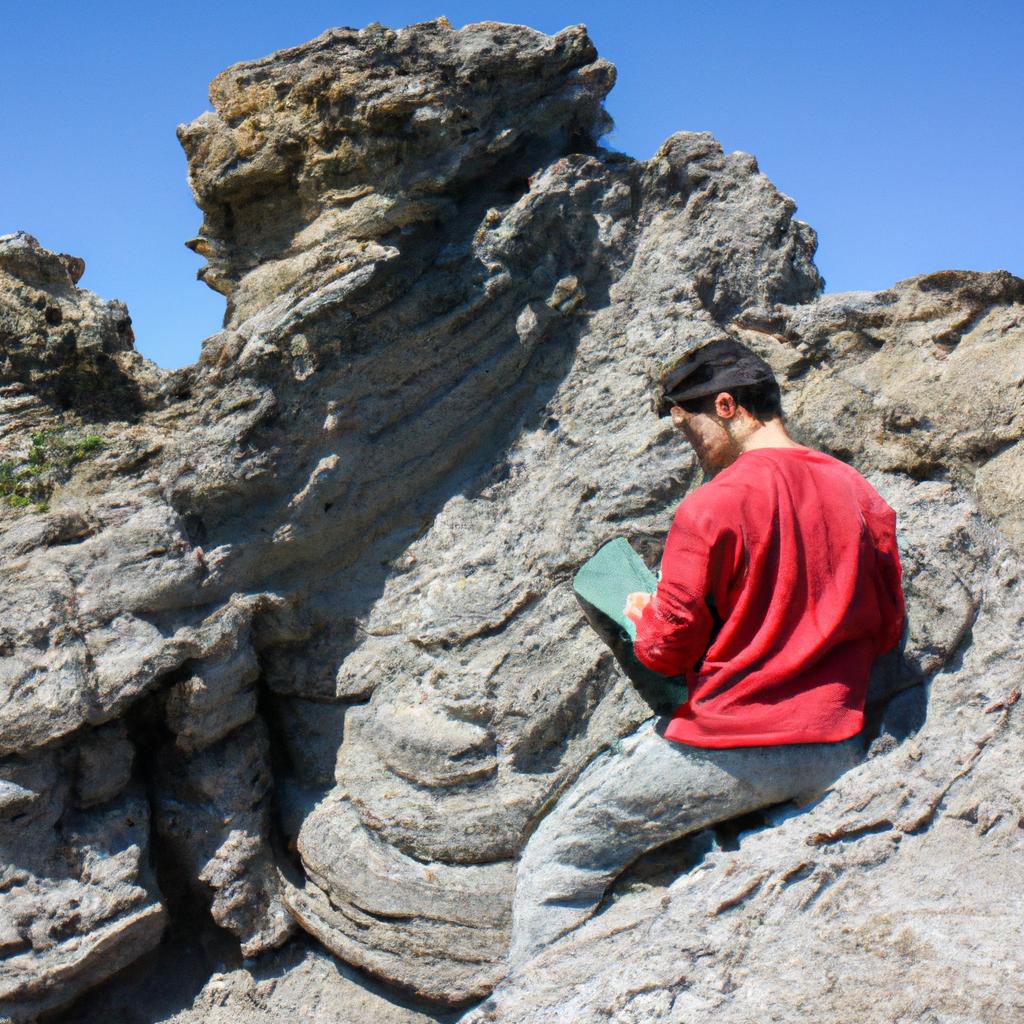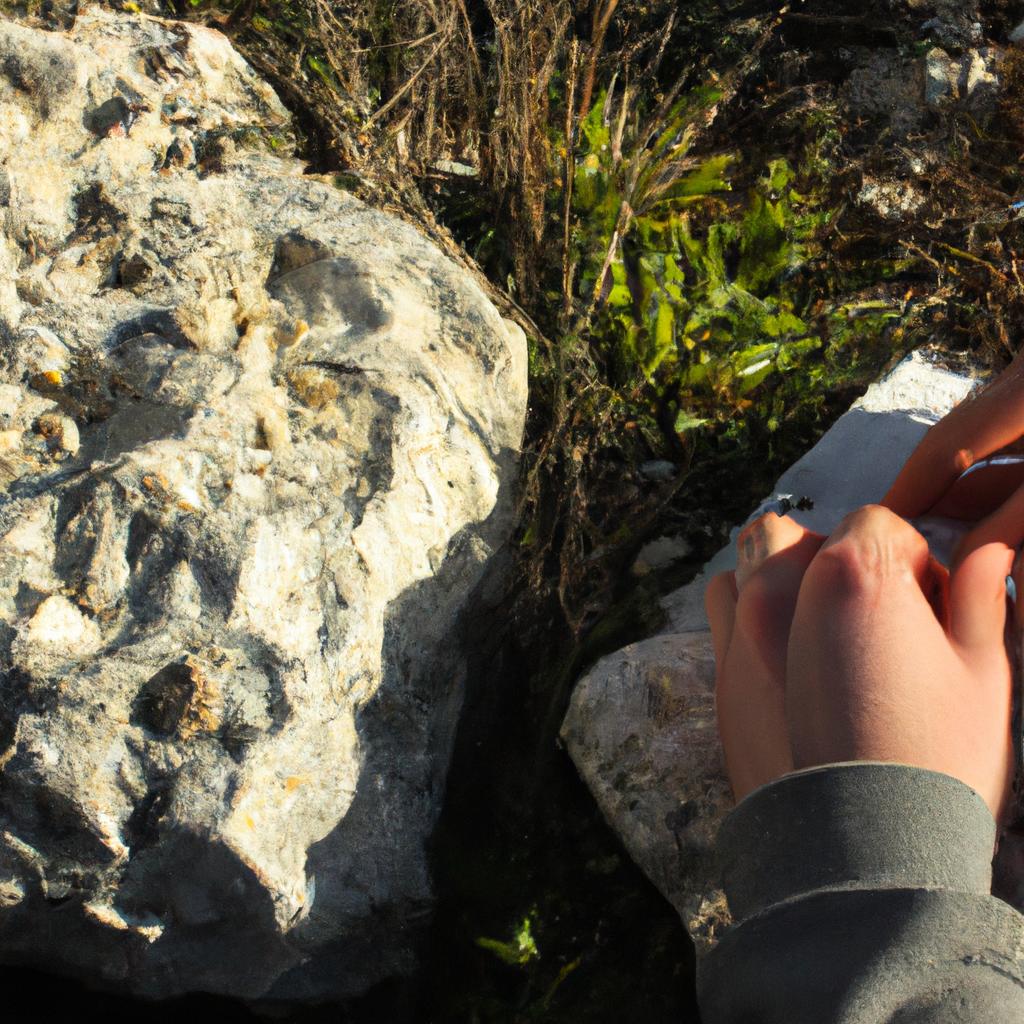Structural geology is an essential sub-discipline within the field of geology, providing a framework for understanding and interpreting Earth’s geological features. By investigating the deformation and arrangement of rocks at various scales, structural geologists strive to unravel the complex history of our planet. One fascinating example that highlights the significance of structural geology is the study of fault lines in California. These intricate networks of fractures have played a crucial role in shaping the state’s landscape and are instrumental in assessing seismic hazards.
At its core, structural geology investigates how forces acting on rocks can result in their deformation and displacement. Through careful examination of rock formations, structures such as folds, faults, joints, and cleavages can be identified. This knowledge not only aids in determining past tectonic events but also provides valuable insights into present-day conditions. Understanding these structures allows scientists to predict potential areas prone to earthquakes or landslides, ultimately contributing to better hazard assessment and mitigation strategies.
The study of structural geology also plays a vital role in resource exploration and extraction industries. By analyzing the characteristics of rock layers and their associated structures, professionals can identify favorable locations for oil reservoirs or mineral deposits. Furthermore, this information helps guide drilling activities by identifying zones with higher fracture density that may enhance permeability and fluid flow.
In addition to its practical applications, structural geology is also important for understanding Earth’s dynamic processes. By studying the deformation of rocks over time, scientists can reconstruct past tectonic events and understand the forces that have shaped our planet’s crust. This knowledge contributes to our broader understanding of plate tectonics, mountain building processes, and the evolution of continents.
Overall, structural geology plays a crucial role in various aspects of geoscience research and applications. From assessing seismic hazards to guiding resource exploration and understanding Earth’s history, this sub-discipline provides valuable insights into the intricate workings of our planet.
Definition of Structural Geology
Structural geology is a branch of geology that focuses on the study and analysis of the deformation and movement within rocks and Earth’s crust. It provides insights into the processes that shape our planet’s geological framework, allowing us to better understand its evolution over time.
To illustrate the importance of structural geology, consider the hypothetical example of an earthquake-prone region. By examining various geological structures in this area, such as faults or folds, scientists can gain valuable information about potential seismic hazards and develop strategies to mitigate their impact. This highlights how structural geology plays a crucial role in assessing natural disasters’ risk levels and formulating appropriate preventive measures.
In studying structural geology, four key concepts emerge:
- Deformation: The process by which rocks change shape due to forces acting upon them.
- Brittle vs. Ductile Behavior: Rocks may respond differently under stress: some will break (brittle behavior) while others deform without fracturing (ductile behavior).
- Strain: Refers to the amount of rock deformation caused by stress; it can be measured through strain markers like foliation or lineation.
- Geological Structures: These are features resulting from deformation processes, including folds, faults, joints, and shear zones.
A table summarizing these concepts is shown below:
| Concept | Description |
|---|---|
| Deformation | Process causing changes in rock shape due to applied forces |
| Brittle vs. Ductile Behavior | Response of rocks under stress – breaking (brittle) or deforming without fracturing (ductile) |
| Strain | Amount of rock deformation resulting from stress |
| Geological Structures | Features produced by deformation processes |
Understanding these fundamental aspects allows researchers to interpret complex geological phenomena accurately. In subsequent sections, we will explore different types of geological structures, further enhancing our understanding of Earth’s geological framework.
Types of Geological Structures
Structural Geology: Earth’s Geological Framework
Definition of Structural Geology sets the foundation for understanding the various types of geological structures that exist on our planet. These structures provide valuable insights into the processes and forces that have shaped Earth over millions of years. In this section, we will delve deeper into the different types of geological structures, exploring their characteristics, formation mechanisms, and significance.
One prominent example of a geological structure is a fault. Faults are fractures in the Earth’s crust where rocks on either side have moved relative to each other. They occur due to tectonic forces acting upon the lithosphere, creating stress and strain within the rocks. One well-known case study illustrating faults is the San Andreas Fault in California, USA, which extends approximately 1,200 kilometers along its length. This fault represents a boundary between two major tectonic plates—the Pacific Plate and the North American Plate—resulting in frequent seismic activity in this region.
To better understand these diverse geological structures, it is important to consider their distinct characteristics:
- Folds: When rock layers bend or buckle under pressure.
- Joints: Fractures without significant displacement.
- Shear Zones: Areas where rocks have been deformed by shear stress.
- Thrust Faults: Low-angle reverse faults resulting from compression.
The following table provides an overview of these key structural features:
| Structure | Characteristics | Formation Mechanism |
|---|---|---|
| Folds | Curved or bent rock layers | Result from compressional or extensional forces |
| Joints | Fractures with no observable movement | Caused by cooling, weathering, or regional stresses |
| Shear Zones | Rocks deformed by intense shear stress | Formed during ductile deformation |
| Thrust Faults | Reverse faults at low angles | Occur when rocks are compressed horizontally or obliquely |
Understanding the various types of geological structures is crucial in unraveling Earth’s complex history. By analyzing these features, geologists can decipher past tectonic events and reconstruct ancient environments. Moreover, this knowledge aids in predicting future seismic activity and identifying potential hazards associated with specific structural configurations.
Moving forward into the subsequent section on Folded Rock Layers, we will explore one of the most visually striking manifestations of geological structures. These folded rock layers provide evidence of powerful compressional forces acting over vast periods, resulting in remarkable formations that showcase nature’s ability to shape our planet.
[Transition sentence: As we delve deeper into the world of Folded Rock Layers…]
Folded Rock Layers
Section H2: Folded Rock Layers
As we delve further into the study of geological structures, it becomes evident that rock layers are not always flat and horizontal. In fact, they can undergo complex deformation processes resulting in folded formations. The phenomenon of folded rock layers provides valuable insights into the tectonic forces shaping our planet’s surface. To illustrate this concept, let us consider a hypothetical example in which sedimentary rocks are subjected to compression along a convergent plate boundary.
Folded rock layers occur when stress is applied to the Earth’s crust, causing the originally planar strata to buckle and fold. This process commonly occurs in regions where two lithospheric plates collide. One such region is the Himalayas, where the Indian subcontinent continues to converge with the Eurasian Plate. Over millions of years, immense compressional forces have caused extensive folding of previously horizontal sedimentary rock layers, giving rise to majestic mountain ranges like Mount Everest.
The formation of folded rock layers has significant implications for understanding Earth’s geological history and structural geology. Here are some key points about these fascinating structures:
- Folding occurs on various scales, ranging from microscopic folds observed under a microscope to large-scale folds spanning kilometers.
- Folds can exhibit different shapes including anticlines (upward arching) and synclines (downward curving).
- Geologists analyze fold geometry and orientation using techniques like bedding attitudes measurements and cross-section construction.
- Understanding folded structures helps unravel past tectonic events, as well as potential hydrocarbon traps and mineral deposits hidden within them.
| Type | Description | Example |
|---|---|---|
| Anticline | Upward arched fold with older rocks at its core | Dome-like structure |
| Syncline | Downward curved fold with younger rocks in its core | Trough-like structure |
| Monocline | Steeply inclined fold with a single limb | Stair-step appearance |
| Recumbent | Folded strata lying almost horizontally | Gentle folds on their sides |
As we explore the intricate world of folded rock layers, it is crucial to remember that these structures are only one piece of the geological puzzle. In the subsequent section about “Faults and Faulting,” we will examine another fascinating aspect of structural geology, shedding light on how fractures and displacements contribute to Earth’s dynamic nature. By comprehending both folded rock layers and faults, we can gain a comprehensive understanding of the complex processes shaping our planet’s surface over time.
Faults and Faulting
Folded Rock Layers provide valuable insights into the dynamic processes that have shaped Earth’s geological framework. By examining these intricate structures, geologists can unravel the tectonic forces and environmental conditions that led to their formation. This section will delve further into the fascinating world of faults and faulting, exploring how these features contribute to our understanding of Earth’s complex history.
One compelling example of faulting is the San Andreas Fault in California, USA. This significant transform boundary separates the Pacific Plate from the North American Plate, resulting in a series of earthquakes as they slide past each other horizontally. The movement along this fault has caused notable displacement over time, highlighting the powerful nature of faulting in reshaping landscapes.
To better comprehend faults and faulting, it is essential to consider several key aspects:
- Types of Faults: Faults can be categorized as either dip-slip or strike-slip based on the direction of movement relative to the orientation of the fault plane. Dip-slip faults involve vertical movement along inclined surfaces, while strike-slip faults exhibit horizontal displacement parallel to the fault surface.
- Fault Zones: Fault zones encompass an interconnected network of fractures within rocks where slip occurs. These zones often extend beyond the main fault trace and may contain secondary faults or subsidiary fractures.
- Seismic Activity: Faults are closely associated with seismic activity, with earthquakes being a direct result of stress release due to sudden slippage along these planes. Monitoring seismic events provides crucial data for studying fault behavior and enhancing our ability to predict future occurrences.
- Geological Hazards: Understanding faults and their potential movements plays a vital role in assessing geological hazards such as landslides, tsunamis, and ground shaking during earthquakes. This knowledge aids in developing effective mitigation strategies for vulnerable regions.
By comprehending these fundamental concepts related to faults and faulting, scientists gain deeper insights into Earth’s ever-changing landscape. It allows us not only to decipher the past but also to anticipate future geological events. In our next section, we will explore another intriguing aspect of Earth’s geological framework: unconformities in geological formations.
Unconformities in Geological Formations reveal gaps in the geologic record, providing valuable clues about periods of missing or eroded time. These discontinuities can occur due to various factors such as erosion, non-deposition, or tectonic activity. Understanding these interruptions allows scientists to reconstruct a more complete picture of Earth’s history and decipher the complex processes that have shaped its surface over millions of years.
Unconformities in Geological Formations
Section H2: Faults and Faulting
In the study of structural geology, faults play a crucial role in understanding Earth’s geological framework. They provide valuable insights into the deformation processes that shape our planet. Now, we turn our attention to another intriguing aspect of Earth’s geological formations – unconformities.
Unconformities represent significant gaps or breaks in the geological record due to erosion or non-deposition of sedimentary layers over extended periods. To illustrate this concept, let us consider an example from the Grand Canyon National Park in Arizona, USA. The Great Unconformity at the base of the canyon showcases a striking contrast between ancient Precambrian rocks and relatively younger Paleozoic sedimentary layers above it. This remarkable boundary highlights millions of years’ worth of missing rock layers, offering a window into past environmental changes and tectonic events.
When exploring unconformities within geological formations, several key aspects come to light:
- Time gaps: Unconformities reveal periods where deposition ceased or erosion took place, indicating intervals when no continuous sedimentation occurred.
- Tectonic activity: Unconformities can result from various tectonic forces such as uplift, subsidence, or faulting that disrupt normal depositional patterns.
- Changes in sea level: Fluctuations in sea levels lead to variations in sediment accumulation rates and subsequent formation of unconformities.
- Geological history reconstruction: By examining unconformities across different regions globally, scientists can reconstruct Earth’s dynamic history, deciphering episodes of mountain building, climate change, and plate tectonics.
To further delve into these concepts and their implications on Earth’s geological development and evolution over vast timescales, we now shift our focus to discussing the significance of structural geology in understanding our planet’s complex history.
Understanding the structural geology of our planet offers valuable insights into its historical processes and the forces that have shaped it. By investigating faults, unconformities, and other geological features, scientists can piece together a comprehensive narrative of Earth’s past. This knowledge not only enhances our understanding of how continents formed and shifted but also sheds light on the origins of natural resources, such as mineral deposits or hydrocarbon reservoirs.
Moreover, by studying the intricate interactions between tectonic plates, researchers gain insight into ancient seismic events like earthquakes and volcanic eruptions. Structural geology enables us to identify potential earthquake-prone areas and assess their associated hazards, thereby contributing to improved disaster preparedness and mitigation strategies.
In summary, the study of structural geology provides a crucial framework for deciphering Earth’s complex history. From unraveling ancient mysteries hidden within unconformities to enhancing our ability to predict future geological phenomena, this field continues to push boundaries in expanding our knowledge about the dynamic nature of our planet.
With an understanding of the significance behind Earth’s geological history established through structural geology, we now delve deeper into exploring specific case studies that showcase these principles in action. In the subsequent section, we will examine examples from different regions worldwide that highlight how structural geology has unraveled fascinating tales buried deep within rocks.
Significance of Structural Geology in Understanding Earth’s History
Unconformities in Geological Formations often provide crucial insights into the Earth’s geological history. By studying these gaps or breaks in sedimentary sequences, geologists can unravel the complex processes that have shaped our planet over millions of years. Now, let us delve deeper into the significance of structural geology in understanding Earth’s history.
One notable example is the Great Unconformity found in the Grand Canyon. This unconformity represents a significant time gap between rocks from different eras, with Precambrian crystalline basement rock underlying much younger Paleozoic sedimentary layers. This observation led to groundbreaking discoveries and sparked debates regarding the missing layers and their implications for Earth’s past environments.
Understanding structural geology contributes to a comprehensive comprehension of Earth’s history by providing valuable information about tectonic events and processes. Here are several key reasons why it plays a pivotal role:
-
Reconstruction of Past Environments:
- Structural analysis allows scientists to reconstruct ancient landscapes and understand how they evolved over time.
- By examining fault patterns and folds within rock formations, researchers can infer past plate movements, mountain-building episodes, and even climate variations.
-
Determining Deformation History:
- Studying structures such as faults, folds, and joints helps establish the timeline of deformation events.
- The identification and dating of various types of deformations contribute to deciphering the intensity and timing of geological activities like earthquakes or mountain uplifts.
-
Unraveling Tectonic Histories:
- Detailed structural studies enable reconstruction of regional-scale tectonic histories.
- These investigations shed light on plate boundaries’ evolution, including subduction zones, collisional belts, or rift systems throughout geological time.
-
Estimating Rock Strength:
- Analyzing structural features aids in determining the strength properties of rocks.
- Understanding rock strength is essential for engineering purposes, resource exploration, and hazard assessments related to landslides or rockfalls.
Table: Examples of Structural Geology Techniques
| Technique | Purpose | Application |
|---|---|---|
| Fault analysis | Determine fault types and movement history | Earthquake hazard assessment |
| Fold geometry analysis | Reconstructing ancient landscapes | Basin evolution studies |
| Joint pattern analysis | Assess rock mass strength and stability | Engineering projects |
| Lineation measurements | Determining stress directions during deformation | Paleostress reconstruction |
In conclusion, the field of structural geology provides indispensable tools for understanding Earth’s history. By examining unconformities in geological formations like the Great Unconformity in the Grand Canyon, scientists can unravel past environments, reconstruct tectonic events, determine deformation histories, and estimate rock strength properties. These insights are crucial for comprehending the dynamic nature of our planet over millions of years and have practical implications in engineering projects, natural hazard assessments, and resource exploration endeavors.












